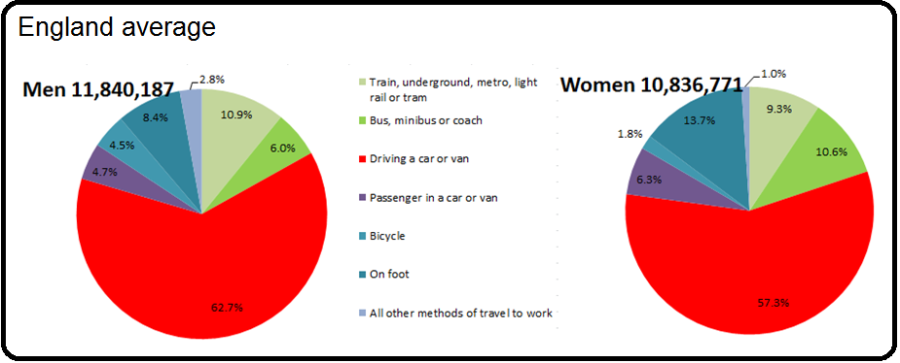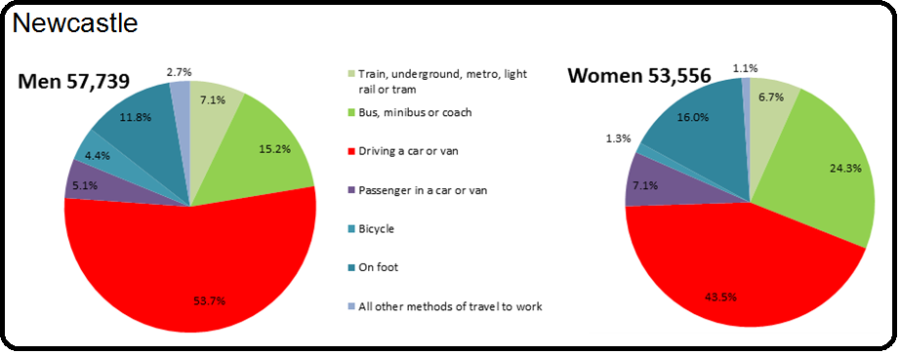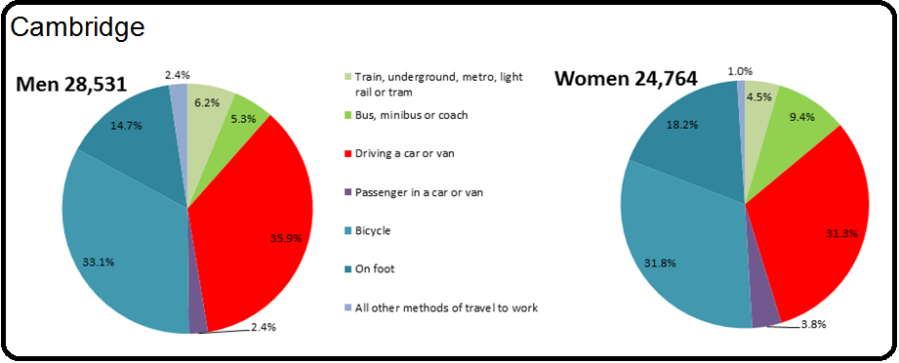With encouraging help and many hints from others (thanks Matt, Rachel, Alex and Vasilis) I have now discovered, and delved into, the massive online data warehouses. To get to know the Census 2011 better I thought it might be good idea to have a general look at basic commuter ‘behaviour’ – the mode share pie.
I also devoured Aldred, Woodcock and Goodman‘s latest – and cross referenced my data outputs where possible (and, phew, it did add up). Aldred et al’s message : Cycling isn’t (as yet) becoming more equal. The cycle-commute remains a younger male prerogative.
They say that “[b]roadly speaking, there are three types of reason, related to trip characteristics, cultural norms, and infrastructural preferences” and, to add, on many junctures of the decision-making process (conscious or not) these three types of reasons may be entangled and different to unpick too – especially given the more complex travel needs of women.
Looking at the Census 2011 data – surprisingly to me, there is almost a 50/50 gender split in the working population. This is an in-out measure and not accounting for part-time workers (which many women particularly may fall under). The numbers say that almost as many women as men work. There are local variations, of course, but the English average gender split is 11,840,187 men : 10,836,771 women.
It is important, I believe, that we start talking about the transport transition. We will have to ask questions like ‘what is the current mode split’, and ‘where do we want to go’. But more vitally and to the point, how will we do that. And there might be gender-specific answers to this. Or as Aldred et al put it “Creating a mass cycling culture may require deliberately targeting infrastructure and policies towards currently under-represented groups”.
In general though, it can be argued that overall the women workforce travel a little bit more greenly than men.
 Correction 1 March 2015: the title should read ‘England average’ – correctly titled file inserted 8 April 2015
Correction 1 March 2015: the title should read ‘England average’ – correctly titled file inserted 8 April 2015
Whilst not cycling much in Newcastle (where 24% of commuter cyclists are women, close to the national average) they do take the bus and walk more than men. Again, through looking at that dataset alone, we cannot distinguish whether this is through choice (health, environment etc), or lack of choice (no car, one car household), or indeed how the decision (conscious or not) was reached in the first instance.
Working women in Newcastle travel quite a bit more sustainably than their gender counterparts.
And here is an example for a city that has kept a better transport trajectory. Cycling is (still) strong in Cambridge. And the gender split in Cambridge cycling is edging on parity. Interestingly the gender mode share pies do not look that different to each other. There might be an important ‘spirit level’ message in that for politicians and practitioners.
Interesting to note, that the London borough of Hackney – despite a high cycle share amongst its residents – may be an outlier when it comes to the gender cycle split: the Hackney cycle commute remains male. I might take a look at that at a later date.
This week there were also plenty of meetings, and seminars, lunchtime talks too. Oh, and media training, everyone’s favourite. My ‘topline’ is “we are building the wrong kind of stuff”.



